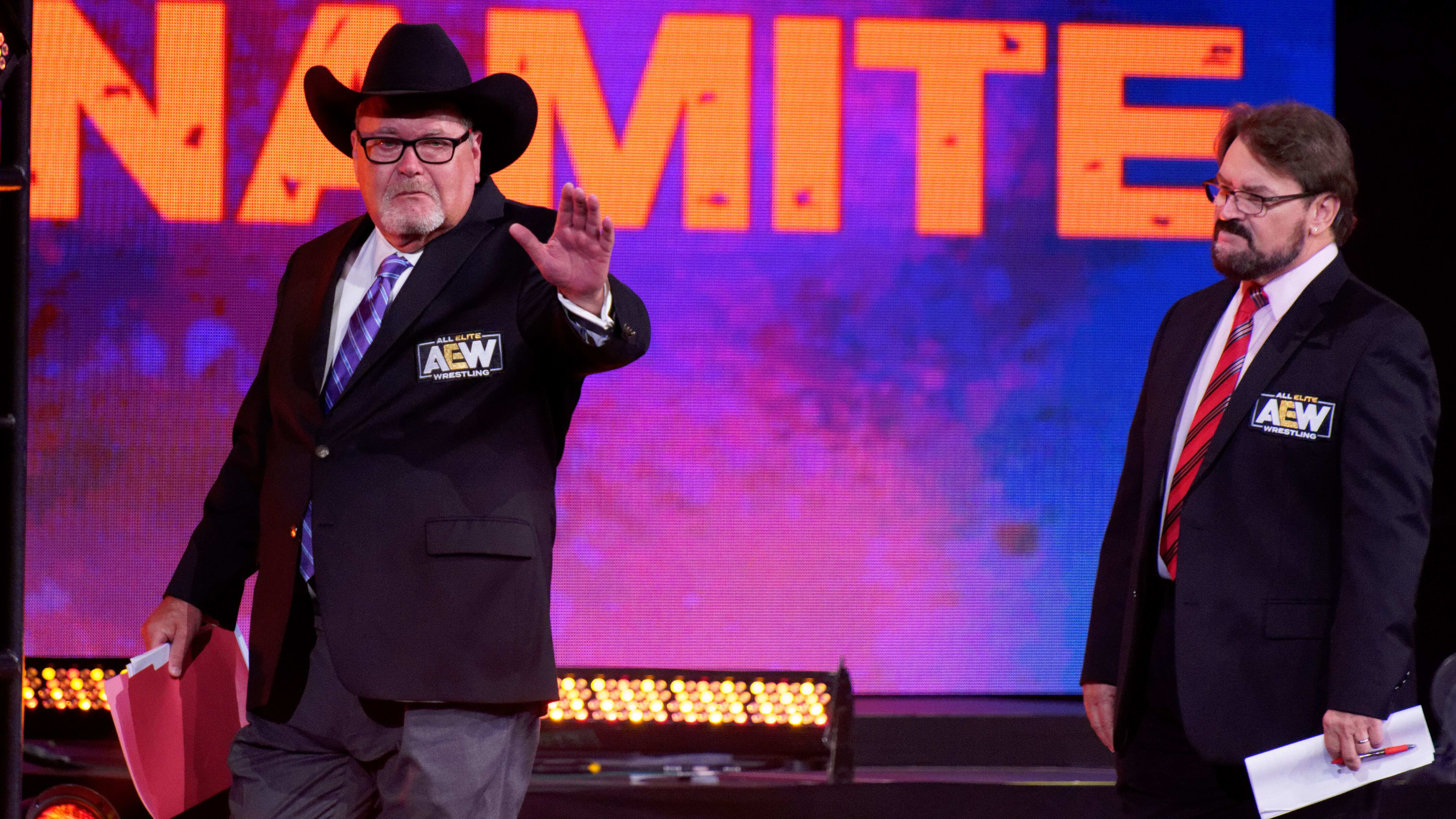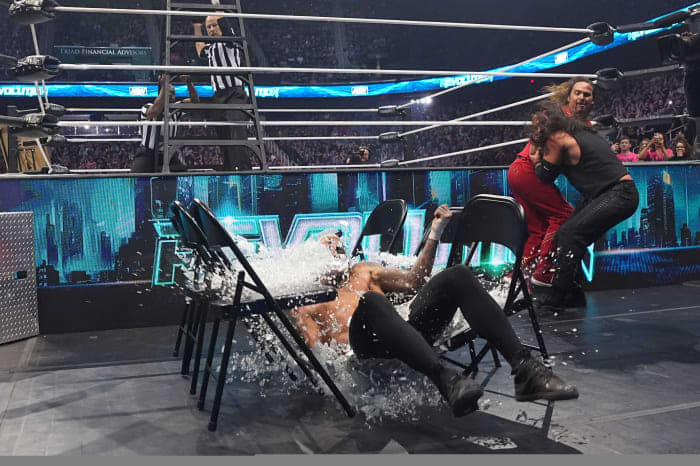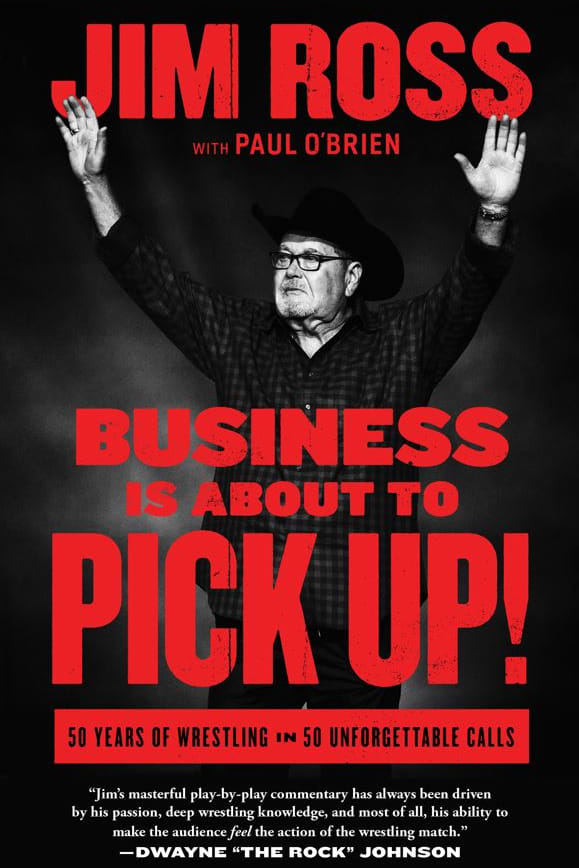- Joined
- Dec 23, 2011
- Messages
- 382,445
- Reaction score
- 154,805
- Points
- 128
- Age
- 28
- Location
- Texas
- Favorite Wrestler
-

- Favorite Wrestler
-

- Favorite Wrestler
-

- Favorite Wrestler
-

- Favorite Wrestler
-

- Favorite Wrestler
-

- Favorite Sports Team
-

- Favorite Sports Team
-

- Favorite Sports Team
-

- Favorite Sports Team
-


Jim Ross on Unforgettable Night at Sting’s Last Match–and His New Book
Ross shared details about his new book–Business is About to Pick Up–and his health
Two months ago, when the iconic Sting bid farewell to professional wrestling with his farewell match, Jim Ross vowed that he would not miss it.
A legend in his own right, Ross held true to his word. He made the connecting flight to Greensboro, North Carolina in his travels–nothing direct was available, not even for the signature voice of the industry–and delivered on a promise that he would be on the headset for the Stinger’s final bout.
There were tables involved in the match, which was a phenomenal brawl between Sting, Darby Allin, and the Young Bucks. There was glass, too. And since this is pro wrestling, a genre that, frighteningly, knows no boundaries, there was a moment in the match when Allin propelled himself off the top of a ladder and smashed onto a plate of glass.

Darby Allin during Sting’s last match
AEW
Not even Ross was excused from the carnage.
Sitting at the broadcast table, in an agony familiar only to a broadcaster with a hot mic, Ross called the match in excruciating pain.
“I had my right hip replaced, and it’s healing nicely, but my surgeon and I failed to schedule a follow-up, so I didn’t realize I had 28 staples in my hip.
“It was my first trip after the hip surgery. I kept thinking to myself, ‘This is painful.’ I thought it was me. Really, it was the staples causing all the pain.”
Ross refused to take pain medication to dull the discomfort. He couldn’t take that risk, knowing he needed his full attention on the match. So he took a page from the larger-than-life stars who he narrates in the ring, and like them, relied upon the adrenaline from the live crowd.
“It was a very emotional night, and that pulse from the people at the Greensboro Coliseum was a great treatment for making my pain subside,” said Ross. “Even if I knew I the adversity I was going to be in, I still would have gone. Sting means the world to me. I wasn’t going to miss it.
“Everybody talks about Sting in WCW, but I met Sting when he was tagging with Rick Steiner–and before that, Jim Hellwig–in Mid-South. When Cowboy [Bill Watts] fired Hellwig, he made sure to tell Sting he was wanted. He’s such a natural babyface. It’s hard to boo the guy. So I dealt with the pain. There are people out there in this world who have it a lot worse than me.”
Ross brings wrestling fans with him on his latest adventure, which is shared in his new book, aptly titled Business is About to Pick Up. It is a unique collection of Ross’ most famed calls.
“Fifty years in the wrestling business, fifty pieces of history documented through these calls,” said Ross. “Writing the book, I enjoyed the hell out of it.”

Jim Ross
Business is About to Pick Up
The story reads more like a memoir, with Ross recalling the origin of his pro wrestling journey on college radio–and brainstorming to bring a new element to the industry. There is depth to the stories behind his calls, which cover classics from Mid-South that were pushed aside by the passing years, all the way to his more recent work in AEW. Of course, the greatest hits from WWE and WCW are featured, as well as a few moments that were memorable for all the wrong reasons.
“Some of the moments were great, some weren’t as great as others–that’s the nature of the beast,” said Ross. “In the book, I cover the Steve Austin-Bret Hart feud, which was really enjoyable. I called their match at WrestleMania, and that’s such a significant match in my career. It was a masterclass by Steve and Bret. There is also a chapter on Barry Horowitz beating Chris Candido. People still talk about that, as crazy as it sounds. There’s a lot of good info. Wrestling fans are going to love it, and it’s going to reconnect them to a lot of memories.”
For Ross, 72, the book accomplished a multitude of goals. It kept him active as he battled cancer, reintroducing him to his first love of wrestling. And it provides a doorway for newer fans to learn about the past. More than 30 years have passed since the classic Ric Flair-Ricky Steamboat feud that closed out the 1980s, though their work remains just as timeless as ever.
“We look at Steamboat and Flair from ’89, which I hope is new information for younger fans,” said Ross. “And if you were watching back then, which a lot of wrestling fans were, I’m looking forward to sharing some new nuggets with you, too.”
Two months ago, when the iconic Sting bid farewell to professional wrestling with his farewell match, Jim Ross vowed that he would not miss it.
A legend in his own right, Ross held true to his word. He made the connecting flight to Greensboro, North Carolina in his travels–nothing direct was available, not even for the signature voice of the industry–and delivered on a promise that he would be on the headset for the Stinger’s final bout.
There were tables involved in the match, which was a phenomenal brawl between Sting, Darby Allin, and the Young Bucks. There was glass, too. And since this is pro wrestling, a genre that, frighteningly, knows no boundaries, there was a moment in the match when Allin propelled himself off the top of a ladder and smashed onto a plate of glass.

Darby Allin during Sting’s last match
AEW
Not even Ross was excused from the carnage.
Sitting at the broadcast table, in an agony familiar only to a broadcaster with a hot mic, Ross called the match in excruciating pain.
“I had my right hip replaced, and it’s healing nicely, but my surgeon and I failed to schedule a follow-up, so I didn’t realize I had 28 staples in my hip.
“It was my first trip after the hip surgery. I kept thinking to myself, ‘This is painful.’ I thought it was me. Really, it was the staples causing all the pain.”
Ross refused to take pain medication to dull the discomfort. He couldn’t take that risk, knowing he needed his full attention on the match. So he took a page from the larger-than-life stars who he narrates in the ring, and like them, relied upon the adrenaline from the live crowd.
“It was a very emotional night, and that pulse from the people at the Greensboro Coliseum was a great treatment for making my pain subside,” said Ross. “Even if I knew I the adversity I was going to be in, I still would have gone. Sting means the world to me. I wasn’t going to miss it.
“Everybody talks about Sting in WCW, but I met Sting when he was tagging with Rick Steiner–and before that, Jim Hellwig–in Mid-South. When Cowboy [Bill Watts] fired Hellwig, he made sure to tell Sting he was wanted. He’s such a natural babyface. It’s hard to boo the guy. So I dealt with the pain. There are people out there in this world who have it a lot worse than me.”
Ross brings wrestling fans with him on his latest adventure, which is shared in his new book, aptly titled Business is About to Pick Up. It is a unique collection of Ross’ most famed calls.
“Fifty years in the wrestling business, fifty pieces of history documented through these calls,” said Ross. “Writing the book, I enjoyed the hell out of it.”

Jim Ross
Business is About to Pick Up
The story reads more like a memoir, with Ross recalling the origin of his pro wrestling journey on college radio–and brainstorming to bring a new element to the industry. There is depth to the stories behind his calls, which cover classics from Mid-South that were pushed aside by the passing years, all the way to his more recent work in AEW. Of course, the greatest hits from WWE and WCW are featured, as well as a few moments that were memorable for all the wrong reasons.
“Some of the moments were great, some weren’t as great as others–that’s the nature of the beast,” said Ross. “In the book, I cover the Steve Austin-Bret Hart feud, which was really enjoyable. I called their match at WrestleMania, and that’s such a significant match in my career. It was a masterclass by Steve and Bret. There is also a chapter on Barry Horowitz beating Chris Candido. People still talk about that, as crazy as it sounds. There’s a lot of good info. Wrestling fans are going to love it, and it’s going to reconnect them to a lot of memories.”
For Ross, 72, the book accomplished a multitude of goals. It kept him active as he battled cancer, reintroducing him to his first love of wrestling. And it provides a doorway for newer fans to learn about the past. More than 30 years have passed since the classic Ric Flair-Ricky Steamboat feud that closed out the 1980s, though their work remains just as timeless as ever.
“We look at Steamboat and Flair from ’89, which I hope is new information for younger fans,” said Ross. “And if you were watching back then, which a lot of wrestling fans were, I’m looking forward to sharing some new nuggets with you, too.”
Ever thoughtful, Ross always insisted on one other feature for his readers.
“The book needed short chapters, and that’s what it’s got,” said Ross. “It’s essentially a quick read. It’s a book you can leave in the bathroom and finish a chapter at a time.”
Seven decades after his start, Ross is still an active player in the industry. He relishes his chance to play a role in AEW, and his Grilling JR podcast with Conrad Thompson continues to grow its audience.
And he is pleased to share that he is doing all of it with a rapidly improving bill of health.
“My health is better than it’s been in over a year, I’m happy to say,” said Ross. “My right hip, that’s healing and getting better. My radiation wound from skin cancer–and I’m cancer-free–is still healing. Vaping has helped. It’s allowed me to stop taking pain medication and get me through the night.
“I’m feeling good. And I’m still doing what I love.”


